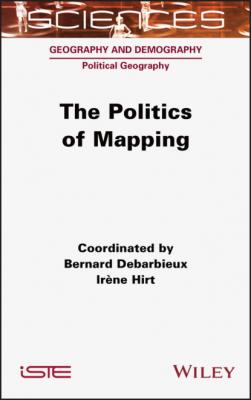ТОП просматриваемых книг сайта:
The Politics of Mapping. Bernard Debarbieux
Читать онлайн.Название The Politics of Mapping
Год выпуска 0
isbn 9781119986744
Автор произведения Bernard Debarbieux
Жанр География
Издательство John Wiley & Sons Limited
However, these chapters take contrasting forms. The first group (Lévy, Farinelli, Gautreau and Noucher, Burini) is made up of essays: they are less concerned with offering a panorama of the academic production on the issues dealt with than with offering a personal reading. A second group (Debarbieux, Dao, Hirt) brings together texts that share a more encyclopedic concern; they attempt to identify the main orientations of the many works related with the chosen theme. A third group (Lardon, Bailly, Clochard) is made up of accounts of experiences: the authors are cartographers who are heavily involved in interactions with administrations, elected officials, groups of inhabitants and associations, and they show practical methods of mapping within particular political contexts: the past 20 years of cartography within the French administration of regional planning (Bailly), various territorial diagnosis and projects of local or regional scope (Lardon) and cartographic works aiming to illustrate migratory issues on modes capable of changing their representations (Clochard).
I.4. References
Akerman, J.R. (ed.) (2017). Decolonizing the Map: Cartography from Colony to Nation. The University of Chicago Press, Chicago.
Amelot, X. (2013). Cartographie participative pour le développement local et la gestion de l’environnement à Madagascar : empowerment, impérialisme numérique ou illusion participative ? L’Information géographique, 77(4), 47–67.
Anderson, B. (2006). Imagined Communities: Reflections on the Origin and Spread of Nationalism, revised edition. Verso, London, New York [Original published 1983].
Arnstein, S.R. (1969). A ladder of citizen participation. Journal of the American Institute of Planners, 35(4), 216–224.
Barney, T. (2014). The Peters projection and the latitude and longitude of recolonization. Journal of International and Intercultural Communication, 7(2), 103–126.
Bertin, J. (1983). Semiology of Graphics: Diagrams, Networks, Maps. University of Wisconsin Press, Madison [Original published in French 1967].
Bertin, J. (2013). Sémiologie graphique : les diagrammes, les réseaux, les cartes. Éditions de l’EHESS, Paris.
Blais, H. (2014). Mirages de la carte : l’invention de l’Algérie coloniale, XIXe–XXe siècle. Fayard, Paris.
Blakemore, M.J. and Harley, J.B. (1980). Concepts in the History of Cartography: A Review and Perspective. B.V. Gutsell, University of Toronto Press, Toronto.
Brandt, W. and Independent Commission on International Development Issues (1980). North-South, A Programme for Survival: Report 11. Pan Books, London.
Brown, G. and Glanz, H. (2018). Identifying potential NIMBY and YIMBY effects in general land use planning and zoning. Applied Geography, 99, 1–11.
Buisseret, D. (ed.) (1992). Monarchs, Ministers, and Maps: The Emergence of Cartography as a Tool of Government in Early Modern Europe. University of Chicago Press, Chicago.
Casti, E. (1993). Cartografia e politica territoriale nella Repubblica di Venezia (secoli XIV–XVIII). In La cartografia italiana, Casti, E. (ed.). Institut Cartogràfic de Catalunya, Barcelona.
Casti, E. (2005). Towards a theory of interpretation: Cartographic semiosis. Cartographica: The International Journal for Geographic Information and Geovisualization, 40(3), 1–16.
Centre Georges Pompidou (ed.) (1980). Cartes et figures de la Terre : exposition présentée au Centre Georges Pompidou du 24 mai au 17 novembre 1980. Centre Georges Pompidou, Centre de création industrielle, Paris.
Cloud, J. (2002). American cartographic transformations during the cold war. Cartography and Geographic Information Science, 29(3), 261–282.
Corbett, J. (2009). Cartographie participative et bonnes pratiques. Etude préparée pour le Fonds international de développement agricole (FIDA). FIDA, Rome [Online]. Available at: http://www.iapad.org/wp-content/uploads/2015/07/ifad_cartographie_participative_et_bonnes_pratiques.pdf.
Craig, W.J., Harris, T.M., Weiner, D. (eds) (2002). Community Participation and Geographic Information Systems. Taylor & Francis, London, New York.
Crampton, J. (2001). Maps as social constructions: Power, communication and visualization. Progress in Human Geography, 25(2), 235–252.
Crampton, J. and Krygier, J. (2006). An introduction to critical cartography. ACME: An International Journal for Critical Geographies, 4(1), 11–33.
Debarbieux, B. (2019). The Social Imaginary of Space. Edward Elgar, Cheltenham.
Debarbieux, B. and Lardon, S. (eds) (2003). Les figures du projet territorial. Éditions de l’Aube and Datar, La Tour d’Aigues.
DelCasino, V. and Hanna, S. (2006). Beyond the “binaries”: A methodological intervention for interrogating maps as representational practices. ACME: An International Journal for Critical Geographies, 4(1), 34–56.
Desbois, H. (2015). Les mesures du territoire : aspects techniques, politiques et culturels des mutations de la carte topographique. Presses de l’ENSSIB, Villeurbanne.
Dodge, M. and Perkins, C. (2015). Reflecting on J.B. Harley’s influence and what he missed in “Deconstructing the Map”. Cartographica: The International Journal for Geographic Information and Geovisualization, 50(1), 37–40.
Edney, M.H. (1997). Mapping an Empire: The Geographical Construction of British India, 1765–1843. University of Chicago Press, Chicago.
Elwood, S. (2008). Volunteered geographic information: Future research directions motivated by critical, participatory, and feminist GIS. GeoJournal, 72(3–4), 173–183.
Farinelli, F. (2009). De la raison cartographique. CTHS, Paris.
Gambier, S., Becks, B., Pedrick, C. (eds) (2016). Le pouvoir des cartes. Quand la 3D s’invite à la table des négociations [Online]. Available at: https://publications.cta.int/fr/publications/publication/1944/.
Gugerli, D. and Speich, D. (2002). Topografien der Nation: Politik, kartografische Ordnung und Landschaft im 19. Jahrhundert. Chronos, Zürich.
Harley, J.B. (1987). The map and the development of the history of cartography. In The History of Cartography, Harley, J.B. and Woodward, D. (eds). The University of Chicago Press, Chicago, London.
Harley, J.B. (1988a). Maps, knowledge, and power. In The Iconography of Landscape: Essays on the Symbolic Representation, Design and Use of Past Environments, Cosgrove, D. and Stephen, D. (eds). Cambridge University Press, Cambridge.
Harley, J.B. (1988b). Silences and secrecy: The hidden agenda of cartography in early modern Europe. Imago Mundi, 40, 57–76.
Harley, J.B. (1989). Deconstructing the map. Cartographica: The International Journal for Geographic Information and Geovisualization,

